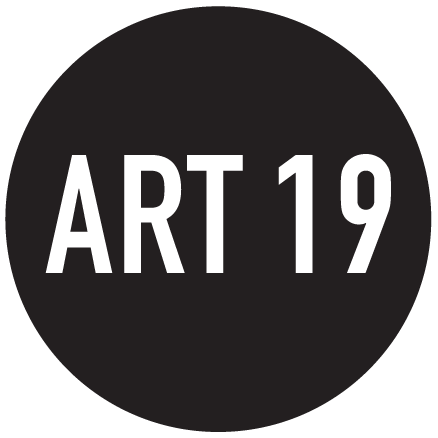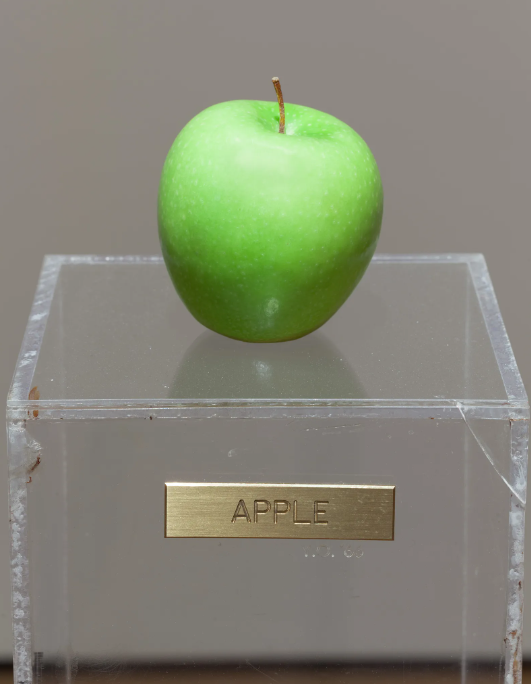Vogue : At Tate Modern’s Reimagining of Yoko Ono’s Oeuvre, the Beatles Are Beside the Point (by Hayley Maitland)
Yoko Ono with Glass Hammer 1967 from HALF-A-WIND SHOW, Lisson Gallery, London, 1967.Photo: Clay Perry
When I speak to Sean Lennon over the phone a few weeks before the opening of Tate Modern’s “Yoko Ono: Music of the Mind,” he’s in his 91-year-old mother’s apartment in Manhattan, a few feet away from a piece of art that irrevocably changed the course of pop culture. Conceived as an interactive work, Painting To Hammer A Nail formed the centerpiece of Yoko Ono’s revelatory 1966 exhibition “Unfinished Paintings” at London’s now-shuttered Indica Gallery—catching the attention of a certain Beatle when he dropped by one frigid November evening to see whether the Japanese artist he’d heard so much about lived up to the hype.
Suffice to say, she did. “There was a sign that said, ‘Hammer a nail in,’ so I said, ‘Can I hammer a nail in?’” John recalled in an interview with Playboy in 1980. “But Yoko said no, because the show wasn’t opening until the next day. But the owner came up and whispered to her, ‘Let him hammer a nail in. You know, he’s a millionaire. He might buy it.’ And so there was this little conference, and finally she said, ‘OK, you can hammer a nail in for five shillings.’ So smart ass says, ‘Well, I’ll give you an imaginary five shillings and hammer an imaginary nail in.’ And that’s when we really met. That’s when we locked eyes and she got it and I got it and, as they say in all the interviews we do, the rest is history.”
Music of the Mind decentralizes Lennon’s influence on Ono and vice versa, although it does include footage of the couple’s Bed-Ins For Peace. “When my mom got together with my dad, her career was sort of swallowed by the chaos and celebrity of the Beatles, and famously, there was a conflict between her universe and their universe—galaxies colliding, as it were,” Sean recalls now. “But my dad had already started to evolve as an artist before that, and my mom was really just the person who helped facilitate that ongoing metamorphosis. It’s her influence that made him capable of writing a song like ‘Imagine,’ which I think says it all, really.”Photo: Central Press/Getty Images
He’s right, of course, but, as “Music of the Mind” makes clear, said history is long overdue for revision where Yoko is concerned. Her story is “more subtle, more interesting, and more nuanced than has ever really been allowed,” Sean—himself a musician—emphasizes in his Transatlantic tones now, “and this exhibition feels, in a lot of ways, like a correction of the accepted narrative about her life, her work.” If MoMA’s “Yoko Ono: One Woman Show, 1960-1971” gave New Yorkers a chance to change their minds about Ono and her oeuvre in 2015, the London-based retrospective does the same for a country that spawned both the Fab Four and some of the most shockingly vitriolic coverage of “The Smart One” and “his wife.” Curated by Juliet Bingham and spanning seven decades of work, it’s a testament to the fact that Ono’s is a talent so towering, a character so cool, that to contemplate either in the shadow of Beatlemania is to do both her and yourself a disservice.
As Sean points out, by the time the 33-year-old Yoko met a 26-year-old John, she had been a rebel and a fantasist, in the best possible sense of both words, for more than three decades—turning personal trauma into performance art almost as soon as she could walk and talk. Yoko’s conservative Japanese grandfather may have told her that her delicate, feminine hands were ill-suited for playing the piano (banking was her family’s preferred career path for her), but she trained classically from the age of four regardless. When, during the Second World War, her parents dispatched her to the countryside after the US Air Force dropped 1,700 tons of firebombs on Tokyo, she would stage “elaborate fantasy dinners” for her brother, Keisuke, and sister, Setsuko, as a way of staving off rationing-related hunger. The latter “is the origin of her understanding of the power of conceptual art,” Sean affirms now.
Various works from the 1966 Indira Gallery exhibition where Yoko first met John are on display as part of Music of the Mind, including Apple 1966), above. Courtesy of the artist. Photo © Thomas Griesel
That power—and her own command of the medium—is manifestly apparent from the moment you step inside Tate Modern and into a white-cubed world of her creations—a place that feels a little bit Marina Abramović, a little bit Yayoi Kusama, and yet wholly original. There are works from her five-year stint in London from 1966 onwards, including her infamous Bottoms video, banned by the British Board of Film Censors before a scheduled screening at the Royal Albert Hall; Apple, comprised of a Granny Smith perched on a plexiglass stand (listed for £200 in “Unfinished Paintings” until John picked up the fruit and took a bite); and her pacifist White Chess Set devoid of black squares and pieces, which instructs visitors to “play as long as you can remember where all your pieces are.” (Yoko has had a lifelong fascination with chess, something she’s passed along to Sean. “War Is Over!”—a short animated film he co-wrote—is nominated for an Oscar this year, depicting two soldiers in opposing camps playing chess against one another without realizing they are, in fact, “enemies.”)
The influence of Japan on Yoko’s creations is also writ large across the gallery space. If, during the Second World War, the constancy of the sky proved a source of solace for her as a child evacuee, its blue vastness recurs throughout the retrospective, from a reimagining of her pioneering ’60s work Sky TV (first created while living in a windowless New York apartment, it now broadcasts the clouds above Tate Modern) to 2001’s Helmets (Pieces of Sky), in which soldiers’ helmets are filled with celestial-print puzzle pieces for visitors to take away and contemplate.
The sky—a central motif in Ono’s work—crops up throughout the retrospective. “She’s truly a conceptual artist,” Sean says of his mother. “Her attitude has always been that the medium is secondary to the mind.” It’s that mentality that allowed her to transition easily into recording albums after meeting Lennon, something that Sean recalls watching fondly while growing up. “I spent a lot of time peering through the glass of the control room, watching musicians record. I remember, at The Hit Factory, there used to be arcade games that I could play. Everyone would just be hanging out, ordering Chinese food. I loved it.” Sky TV (1966/2014). Courtesy of the artist. Installation view courtesy of Hirshhorn Museum and Sculpture Garden. Photo © Cathy Carver
This is, at its core, a playfully interactive exhibition—one whose central thesis might be summed up as: we’ve been taking Yoko Ono too seriously—and yet we haven’t been taking Yoko Ono seriously enough. All 150 typewritten pages of her instructional 1964 volume Grapefruit are displayed on the walls (“Carry a bag of peas. Leave a pea wherever you go”; “Imagine the clouds dripping”; “Smoke everything you can. Including your pubic hair”). People are invited to shake hands through a hole in a blank canvas; slip into sacks like those worn by John and Yoko during the Bagism years; scrawl messages of hope all over a refugee boat in Add Color (2016). And then there’s the various feminist messages interwoven throughout—see Yoko struggling to tear off her bra in Freedom (1970), or her video Fly from the same year, in which an insect crawls all over a women’s nude body as Ono sings in the background. And at the exhibition’s close? You’ll find a 15-meter-long wall, where visitors can pen messages and post photographs in tribute to their mothers.
For his part, Sean has gone one better, launching a website inspired by Yoko’s Wish Tree series, where fans can plant a tree on his mother’s behalf. “People always assume that I became a musician because of my dad’s influence, but really, it’s primarily my mom’s. She’s completely unfazed by public opinion. I remember, as a teenager, telling her I thought Yoko Ono/Plastic Ono Band was so crazy and great, and that she should do more experimental music like that. So she headed into the studio and made Rising, letting me play the drums on the EP as an 18-year old with almost no experience. This is someone who had been in the room when the Beatles were recording, who had co-written ‘Imagine’—even if it took a while for her to be credited for that—and she just let her teenager handle the backing band. She could have made that album with Steve Gadd on drums, but she didn’t. That’s how brave and open and radical she actually is.” Imagine a world in which that’s finally recognized.
Article published on https://www.vogue.com




